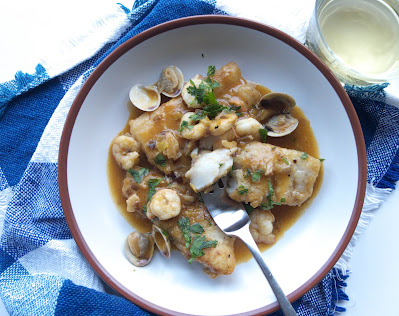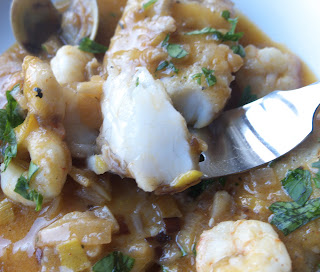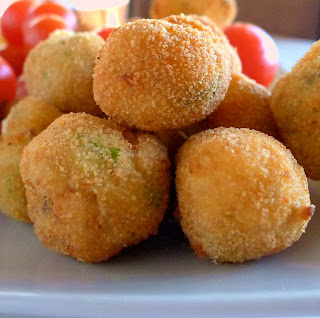I´m back in my kitchen in Spain, after a visit to family in the U.S. How cold and drafty my house is! After weeks with central heating, double-glazing, soft carpets, walking across cold tile floors, I am shivering and pulling on extra sweaters and socks. I have to make soup!
Once I sleep off the exhaustion and jet-lag, I high-tail it to the grocery store to stock the pantry—a heap of vegetables for home-made soup and a chicken to roast for dinner. Ah, feeling warmer already.
It is the first sip of tea in the morning that warms me and reminds me of what I love about home. It’s just plain old English breakfast tea, but it´s brewed with pure, unchlorinated water from the well on my land. It tastes completely different from the same tea, made with city tap water.
And, I´ve finally got my preferred yogurt—no fat, no sweetening, no fruit or flavors added, with probiotics. With chopped apple and a couple of almonds, cracked and chopped, that’s breakfast. In the U.S., I felt a guilty eating whole-milk yogurt, but I quite liked substituting crunchy grape nuts for the almonds. About the apples—they were better in the U.S. than in Spain. More varieties at the grocery and sweeter and crisper. Fruit, in general, was excellent there, though it was a little disconcerting to have so much out-of-season imported fruit. Although the clementines from Chile were excellent, the ones I pick in my garden are better!
 |
| Café con leche in a glass. |
Coffee at the café in the village plaza, after my first day back to morning aerobics, elicits a sigh of pleasure. An espresso brew con leche, with just a little foam, the coffee is served in a small glass, a perfect handwarmer on a chill day. American coffee tastes too acidic to me.
I still haven´t got back my land legs. By that I mean I´m unsteady traversing uneven ground around my house. I go out to pick some lemons, hang out the laundry to dry, take the garbage to the compost at the far end of the property, walk uphill to the mailbox on the carretera, set up the goteo (drip irrigation) for the avocado and mango trees. Where I was staying with Daniel and Eli, in an Atlanta suburb, you don’t go outside except “to go for a walk” or, if you´re Nico, to shoot some hoops in the driveway.
Back in my own kitchen, at first I am distressed at my own untidiness—objects shoved into corners and piled on open shelves. I admire Daniel and Eli for keeping their big kitchen ship-shape, washing up every night and putting everything away. But, after cooking a few meals at home, I quickly fall back into my old, comfortable patterns—wash up in the morning and, with fewer people in the house, run the dish washer every third day (after midnight, to save on electricity).
I´m glad to have my own “stuff” that makes recipe testing easier, plus dishes, bowls and other props for food styling. Trying to put up the blog from someone else´s kitchen was a challenge!
 |
Trying out a new carbon steel skillet.
|
I have a new kitchen tool, a Christmas gift to myself—a carbon steel skillet. I should have gotten a smaller one—4.3 pounds is not “heavy” if it´s a bag of oranges, lifted with two hands, but, hefted one-handed by a long handle, it´s more than I can manage. And, turns out, it almost doesn´t fit in my small, European oven.
Still, I “seasoned” it and I´m ready to try it out! What to cook? I choose fresh ibérico pork chops, marbled with fat. (My American family eats lean—chicken breast and lean beef. At one family meal, we had thick-cut pork chops cooked on the grill on the deck. I watched them all carefully cut away and discard the rim of fat on the chops. I finally reached over and speared some of that juicy deliciousness from Lucas´s plate.)
 |
| Thick-cut ibérico pork chops are seared then finished in a covered pan with sliced apples. Medium Sherry to deglaze the pan creates a delicious sauce. |
 |
| Pork chops and apples with an oloroso Sherry sauce, brussels sprouts and, no not mashed potatoes, but crushed parsnips. Dinner is served at home. |
 |
| Fresh ibérico pork stays juicy due to marbling of fat. |
Ibérico Pork Chops with Apples and Sherry
Chuletas Ibéricas con Manzana y Oloroso Seco
 |
| Chops are 1 ½ inches thick, each weighing 9 ½ ounces. |
3 thick-cut porkchops
Salt
Freshly ground pepper
Chopped parsley
1 teaspoon fresh lemon juice
Sprigs of rosemary
2 teaspoons olive oil
1 apple, cored and sliced
1 tablespoon water
¼ cup oloroso seco Sherry
Sprinkle one side of the chops with salt, pepper, parsley and lemon juice. Place sprigs of rosemary on top. Allow to stand 30 minutes.
Heat a heavy skillet on high. Add the oil and reduce heat to moderate. Sear the chops, unsalted side down first, until browned, 1 minute. Turn and sear the other side. Add the apples to the pan with the water. Cover and cook on moderately-low heat, turning once, until the meat is barely cooked through (145ºF on an instant-read thermometer), 5 to 8 minutes. Remove the chops and apple slices from the pan and keep them warm. Discard the sprigs of rosemary.
Add the Sherry to the pan and use a wooden paddle to scrape up any drippings. Bring to a boil and simmer until slightly reduced. Serve the sauce with the pork chops and apples. Garnish, if desired, with fresh sprigs of rosemary.






































